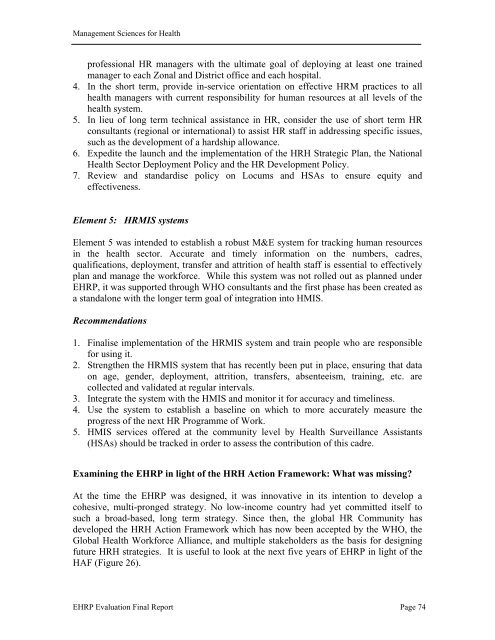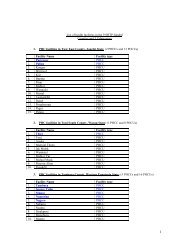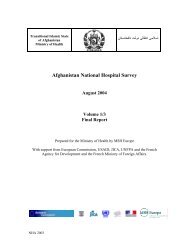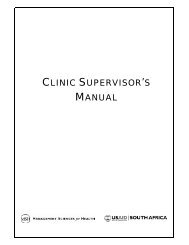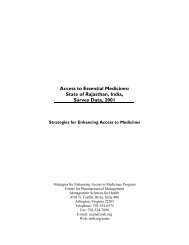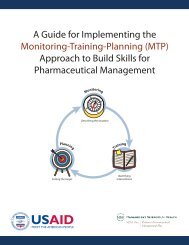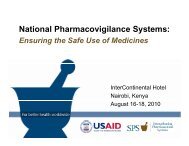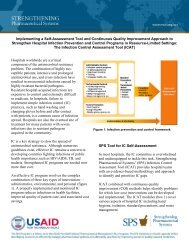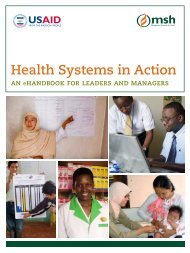Evaluation of Malawi's Emergency Human Resources Programme
Evaluation of Malawi's Emergency Human Resources Programme
Evaluation of Malawi's Emergency Human Resources Programme
You also want an ePaper? Increase the reach of your titles
YUMPU automatically turns print PDFs into web optimized ePapers that Google loves.
Management Sciences for Health<br />
pr<strong>of</strong>essional HR managers with the ultimate goal <strong>of</strong> deploying at least one trained<br />
manager to each Zonal and District <strong>of</strong>fice and each hospital.<br />
4. In the short term, provide in-service orientation on effective HRM practices to all<br />
health managers with current responsibility for human resources at all levels <strong>of</strong> the<br />
health system.<br />
5. In lieu <strong>of</strong> long term technical assistance in HR, consider the use <strong>of</strong> short term HR<br />
consultants (regional or international) to assist HR staff in addressing specific issues,<br />
such as the development <strong>of</strong> a hardship allowance.<br />
6. Expedite the launch and the implementation <strong>of</strong> the HRH Strategic Plan, the National<br />
Health Sector Deployment Policy and the HR Development Policy.<br />
7. Review and standardise policy on Locums and HSAs to ensure equity and<br />
effectiveness.<br />
Element 5: HRMIS systems<br />
Element 5 was intended to establish a robust M&E system for tracking human resources<br />
in the health sector. Accurate and timely information on the numbers, cadres,<br />
qualifications, deployment, transfer and attrition <strong>of</strong> health staff is essential to effectively<br />
plan and manage the workforce. While this system was not rolled out as planned under<br />
EHRP, it was supported through WHO consultants and the first phase has been created as<br />
a standalone with the longer term goal <strong>of</strong> integration into HMIS.<br />
Recommendations<br />
1. Finalise implementation <strong>of</strong> the HRMIS system and train people who are responsible<br />
for using it.<br />
2. Strengthen the HRMIS system that has recently been put in place, ensuring that data<br />
on age, gender, deployment, attrition, transfers, absenteeism, training, etc. are<br />
collected and validated at regular intervals.<br />
3. Integrate the system with the HMIS and monitor it for accuracy and timeliness.<br />
4. Use the system to establish a baseline on which to more accurately measure the<br />
progress <strong>of</strong> the next HR <strong>Programme</strong> <strong>of</strong> Work.<br />
5. HMIS services <strong>of</strong>fered at the community level by Health Surveillance Assistants<br />
(HSAs) should be tracked in order to assess the contribution <strong>of</strong> this cadre.<br />
Examining the EHRP in light <strong>of</strong> the HRH Action Framework: What was missing?<br />
At the time the EHRP was designed, it was innovative in its intention to develop a<br />
cohesive, multi-pronged strategy. No low-income country had yet committed itself to<br />
such a broad-based, long term strategy. Since then, the global HR Community has<br />
developed the HRH Action Framework which has now been accepted by the WHO, the<br />
Global Health Workforce Alliance, and multiple stakeholders as the basis for designing<br />
future HRH strategies. It is useful to look at the next five years <strong>of</strong> EHRP in light <strong>of</strong> the<br />
HAF (Figure 26).<br />
EHRP <strong>Evaluation</strong> Final Report Page 74


